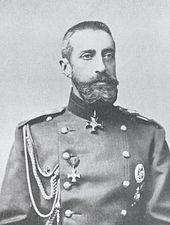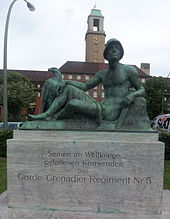Guard Grenadier Regiment No. 5
|
Guard Grenadier Regiment No. 5 |
|
|---|---|
| active | March 31, 1897 |
| Country | Kingdom of Prussia |
| Armed forces | Prussian Army |
| Branch of service | infantry |
| Insinuation | Guard Corps |
| Former locations | Spandau |
The Grenadier Guards Regiment. 5 was an infantry joined the Guard Corps of the Prussian army .
history
The regiment was formed on March 31, 1897 (Foundation Day) from the IV (half) battalions of the 2nd and 4th Guards Regiments on foot , the Kaiser Alexander Guard Grenadier Regiment No. 1 , the Kaiser Franz Garde Grenadier -Regiment No. 2 formed. It formed two battalions and was stationed in Spandau . The regimental staff, the 1st battalion and the 5th and 6th companies were quartered in the Stresow barracks I, the 7th company in the Moritz barracks and the 8th company in the barracks I. From October 1, 1913, the fusilier battalion (9th to 12th company) newly established as part of the army reinforcement in 1913 was housed in the barracks on the parade ground next to the fortress prison, and the MG company in Stresow barracks I.
The association was subordinate to the 5th Guard Infantry Brigade of the 2nd Guard Division .
First World War
With the outbreak of the First World War , the regiment mobilized on August 2, 1914 and was initially deployed in the west near Namur with the 5th Guard Infantry Brigade as part of the 3rd Guard Division . At the end of August, the superior Guard Reserve Corps was transferred to the Eastern Front and took part in the Battle of the Masurian Lakes . In May 1915 the regiment returned to the Western Front, participated in the trench warfare in Flanders and Artois, and then entered the Battle of the Somme . During the further course of the war the regiment fought in the west a. a. still at Arras , in Flanders and the German spring offensive from the end of March 1918.
Whereabouts
After the end of the war and return home, the demobilization in Spandau took place on December 12, 1918 . From January 21, 1919, parts of the regiment began to set up the “Spandau” volunteer battalion. At the end of March 1919 it was transferred to the "von Hindenburg" volunteer corps as the 2nd Battalion . With the establishment of the Provisional Reichswehr from October 1919 it was the IVth Battalion of the Reichswehr Infantry Regiment 102.
The tradition took over in the Reichswehr by decree of the chief of the army command, General of the Infantry Hans von Seeckt , from August 24th 1921 the 5th and 6th companies of the 4th (Prussian) Infantry Regiment in Kolberg . In the Wehrmacht , the 6th and 7th companies of the 67th Infantry Regiment in Spandau continued the tradition.
Regiment chief
The first and only head of the regiment since August 9, 1897 was Grand Duke Konstantin Konstantinowitsch Romanov .
Commanders
| Rank | Surname | date |
|---|---|---|
| Colonel | Eberhard von der Lancken | April 1, 1897 to April 17, 1901 |
| Colonel | Kurt von Manteuffel | April 18, 1901 to January 26, 1903 |
| Colonel | Eberhard von Claer | January 27, 1903 to February 15, 1907 |
| Colonel | Johannes von Eben | February 16, 1907 to September 24, 1908 |
| Colonel | Karl Heinrich von Hänisch | September 25, 1908 to October 12, 1910 |
| Colonel | Hans von Langermann and Erlenkamp | October 13, 1910 to April 1, 1913 |
| Colonel | Axel von Petersdorff | April 2, 1913 to August 1, 1914 |
| major | Walter Randt | August 2 to December 19, 1914 (in charge of the tour) |
| major | Wilhelm Reinhard | December 20, 1914 to June 2, 1915 (responsible for the tour) |
| Lieutenant colonel | Walter Randt | June 3, 1915 to January 9, 1917 |
| Lieutenant colonel | Kurt von Beerfelde | January 10, 1917 to April 9, 1918 |
| Lieutenant colonel | Karl von Kietzell | April 10 to December 12, 1918 |
uniform
The uniform of the Guard Grenadiers consisted of a blue tunic with a red collar and matching Brandenburg lapels with dark blue sleeve flaps , but had a wide yellow camel yarn Old Prussian braid on the collar and three similar braids on the sleeve flaps . There were also white epaulettes , tombac buttons, white leather gear and white (guard) helmet bushes. Unlike the other Guard regiments, there was no fusilier battalion.
Uniforms of NCOs had differently patterned braids on the collar and lapels.
Uniforms for officers were equipped with old Prussian golden embroidery in place of the braids on the collar and on the sleeve flaps.
Uniform changes
- June 15, 1898: The flag bearers receive a cloth badge on the right upper arm and the ring collar.
- May 1, 1899: Gardelitzen on the cloak collar tips for NCOs and grenadiers.
- March 14, 1902: The standard bearers receive a bandolier made of red Russia with a gold braid and shoe.
- January 27, 1903: The teams trained as winkers receive two crossed flags on the lower arm.
- 1913: The new field gray uniform, gradually introduced since 1907, was worn for the first time for the autumn exercises. Field gray skirt with foldable collar and flaps; on the collar mirror with yellow camel thread; on the flaps also these strands; matt buttons with royal crown; gray armpit flaps; gray cotton scarf instead of the bandage; field gray pants; field gray caps with red trim; black leather stuff.
monument
"His comrades who fell in the World War" was ceremoniously unveiled on May 21, 1922 by former members of the regiment in the Stabholzgarten park in the old town of Berlin-Spandau (see Monuments in Spandau ) based on a design by the Dresden sculptor August Schreitmüller .
literature
- Jürgen Kraus : Handbook of the associations and troops of the German army 1914-1918. Part VI: Infantry. Volume 1: Infantry Regiments. Verlag Militaria, Vienna 2007, ISBN 978-3-902526-14-4 , p. 33.
- Albrecht von Stosch: Das Garde-Grenadier-Regiment Nr. 5, 1897-1918 (= memorial sheets of German regiments. Troop units of the former Prussian contingent . Volume 122 ). Stalling, Oldenburg iO / Berlin 1925. Available online: digitized version of the Württemberg State Library .
Web links
Individual evidence
- ^ Günter Wegmann (Ed.), Günter Wegner: Formation history and staffing of the German armed forces 1815-1990. Part 1: Occupation of the German armies 1815–1939. Volume 2: The staffing of active infantry regiments as well as jäger and MG battalions, military district commands and training managers from the foundation and / or list until 1939. Biblio Verlag, Osnabrück 1992, ISBN 3-7648-1782-8 , p. 25.



